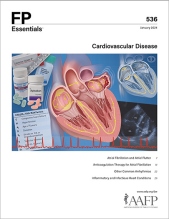
This clinical content conforms to AAFP criteria for CME.
Acute pericarditis, the most common inflammatory heart condition, typically is caused by viral infections. Patients have sharp chest pain that improves when leaning forward. Electrocardiogram typically shows widespread ST-segment elevation; echocardiogram may show pericardial effusion; and levels of inflammatory markers may be elevated. Colchicine plus nonsteroidal anti-inflammatory drugs are first-line treatment. Patients with fever, elevated inflammatory marker levels, or pericardial effusion should be hospitalized. Myocarditis also commonly is caused by viruses, although some cases are due to autoimmune or other conditions. Symptoms include chest pain, dyspnea, and fever. Although endomyocardial biopsy is the definitive diagnostic test, most cases are diagnosed based on clinical symptoms, electrocardiogram, echocardiogram, and cardiac markers, plus excluding other conditions. Patients with heart failure should receive guideline-recommended therapy, plus treatment of underlying conditions (eg, autoimmune conditions). Infective endocarditis is caused by infection of cardiac valves, chambers, or intracardiac devices. There are many causative organisms, but Staphylococcus aureus is most common. Fever is the most frequent symptom, although some patients have systemic emboli or heart failure. The modified Duke criteria can aid in diagnosis, which is confirmed by positive blood cultures. Antibiotics are started immediately after obtaining blood cultures, modified based on culture results, and continued for 4 to 6 weeks after first negative culture.
Subscribe
From $350- Immediate, unlimited access to FP Essentials content
- 60 CME credits/year
- AAFP app access
- Print delivery available
Edition Access
$44- Immediate, unlimited access to this edition's content
- 5 CME credits
- AAFP app access
- Print delivery available
